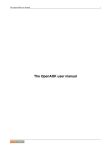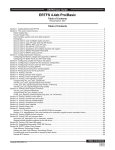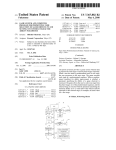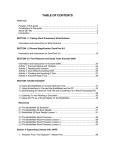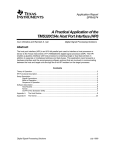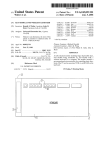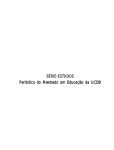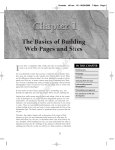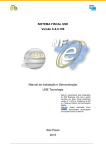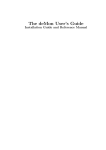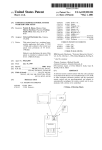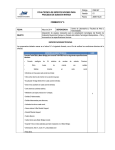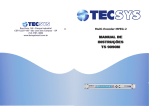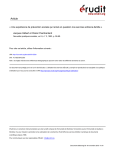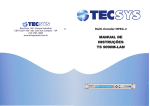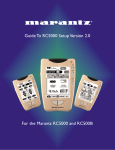Download Rules-based configuration problem detection
Transcript
US00705l243B2 (12) United States Patent (10) Patent N0.: US 7,051,243 B2 (45) Date of Patent: May 23, 2006 Helgren et a]. (54) RULES-BASED CONFIGURATION PROBLEM DETECTION 5,867,714 A 5,897,630 A 2/1999 Todd et a1. 4/1999 Schneider (75) Inventors: Matthew J. Helgren, Austin, TX (US); 5,922,079 A 7/1999 Booth et al' Huddleston Virta et a1. Michael E. Little, Cedar Park, TX i (US); Paris E. Bingham, Jr., Aurora, ’ en e a' CO (US); Rex G. Martin, Plano, TX (US); Alan J. Treece, St. Peters, MO (Continued) (Us) FOREIGN PATENT DOCUMENTS . EP (73) Ass1gnee: Sun Microsystems, Inc., Santa Clara, CA (Us) (*) Notice: 367 377 Subject to any disclaimer, the term of this ' ' ' ( ) y OTHER PUBLICATIONS Search Report from UK Patent Application No. 03094851, ays' mailed Nov. 27, 2003, 6 pages. (21) Appl. N0.: 10/135,483 (65) Primary ExamineriRobert W. Beausoliel, Jr. _ _ Assistant ExamineriYolanda L. Wilson Pnor Pubhcatlon Data (51) Us Int CL G06F 11/00 (52) (58) (Continued) Apr- 30, 2002 _ 5/1990 (Continued) $12318 11S sixteng$142; adjusted under 35 (22) Filed: Sin“? 1 ’ (74) Attorney, Agent, or FirmiRobert C. Kowert; Oct~ Meyertons, (57) HOOd, KIVIIII, ABSTRACT Kowert & GoetZel, (2006.01) US. Cl. ........................... .. 714/48; 714/26; 714/ 37 Field of Classi?cation Search ................ .. 714/48, 714/37’ 26’ 47 A system and method for identifying problems with a system Con?guration may evaluate system con?guration informa tion against one or more con?guration recommendations or See application ?le for complete Search history, rules. The evaluated system con?guration may include vari ous types of software and hardware components which may (56) References Cited impact the operations of the computer system. Rules may be any information identifying an issue or describing a recom US. PATENT DOCUMENTS 4,447,846 A 5/1984 Mccleery 4,853,873 A 8/1989 Tsuji et a1‘ 5,111,384 A 5/1992 Aslanian et a1. 5,175,800 A 12/ 1992 Galis et a1. 5,179,695 A 1/1993 Deff et a1~ 5387505 A 2/1994 Calven et a1~ 5335341 A 8/1994 Charla 5’664’093 A 9/1997 Barnett et 31' 5,678,002 A 10/1997 Fawcett et al. 5,826,250 A 10/1998 Tre?er 5,862,322 A mended con?guration for the software or hardware compo nent. A knowledge-based language or a programming lan guage analyzer may be used to specify the rules. In one embodiment, a rules engine may be used as part of the problem detection application to evaluate con?guration data against associated rules. A rules engine may be any mecha nism used to recognize, interpret and process the con?gu ration data against the rules. The results of the evaluation rocess ma be stored for further anal sis p y 1/1999 Anglin et a1. y ' 44 Claims, 8 Drawing Sheets System 10.1 Soitware Components 11_0 Hardware Components 12a "" iiSBiIiSQi-Eélfiiiiéiiéi""Q 1.00 Configuratiom : i Rules Data F m m ------------- Problem Results 1512 : US 7,051,243 B2 Page 2 US. PATENT DOCUMENTS 5,974,568 A 10/1999 McQueen 6,029,258 6,170,065 6,219,626 6,298,308 6,327,677 6,349,335 6,470,464 6,487,677 6,529,954 6,532,408 6,549,893 6,560,592 6,604,141 6,615,172 6,629,267 6,633,782 6,633,876 6,678,639 6,681,348 6,701,514 6,738,928 6,738,932 6,742,141 6,859,893 A B1 B1 B1 B1* B1* B1* B1 B1 B1 B1 B1 B1 B1 B1 B1 B1 B1 B1 B1 B1 B1 B1 B1 2/2000 1/2001 4/2001 10/2001 12/2001 2/2002 10/2002 11/2002 3/2003 3/2003 4/2003 5/2003 8/2003 9/2003 9/2003 10/2003 10/2003 1/2004 1/2004 3/2004 5/2004 5/2004 5/2004 2/2005 2002/0073195 A1* 6/2002 2002/0078404 2002/0095615 2003/0028825 2003/0028857 A1 A1 A1* A1 Patwardhan, et al., “Perl in a Nutshell,” O’Reilly, Dec. 1998, ISBN: 1-56592-286-7, 1 page. Steve Oualline, “Practical C Programming,” 3rdEdition, O’Reilly, Aug. 1997, ISBN: 1-56592-306-5, 3 pages. Ahmad Kobata et a1. Steinmetz et al. Reid et a1. Pittelli, et al., “Reliable Scheduling in a TMR Database System, ” ACM, Feb. 1999, 2 pages. “XML iThe Bene?ts,” Version found via “The Way Back Machine,” Feb. 26, 2000, http://www.softwareag.com/Xml/ about/xmlibenhtml, 3 pages. Janice Winsor, “Solaris 8 System Administrator’s Refer Cookmeyer, et al. Breed Lannert et a1. Reid et a1. Ventura Bennett et a1. Glerum et a1. Schleiss et a1. Heatlie Little et a1. Vachon Haswell et al. Brown Price Miller Hines ence,” Prentice Hall PTR, Sep. 7, 2000, ISBN: 0-13 027701-0, 2 pages. Paul McFedries, “Windows 98 Unleashed, ” Sams Publish ing, Mar. 12, 1998, ISBN: 0-672-31235-2, 4 pages. “RS232 Interface: A Tutorial,” Version from Oct. 4, 1999 found via “The Way Back Machine,” http://arcelect.com/ rs232.html, 2 pages. “How Does Human Memory Compare with Computer Memory,” Version from Nov. 11, 1999 found via “The Way Back Machine,” http://www.scism.sbu.ac.uk/inmandw/tuto rials/memory/qu8.htm, 4 pages. Alligator Descartes, et al., “Programming the Perl DBI,” O’Reilly and Associates, Feb. 2000, ISBN: 1-56592-699-4, 2 pages. Hellerstein et a1. ....... .. 709/224 6/2002 Vachon et al. 1986. 0-89791-210-1/86/1000-0113, 1 page. 7/2002 Hastings et a1. 2/2003 Hines ........................ .. James Kavicky, et al., “An Expert System for Diagnosing 714/37 2/2003 Zagorski et al. FOREIGN PATENT DOCUMENTS GB 2 383 854 7/2003 OTHER PUBLICATIONS Service Pack Manager 2000, User Manual, “Gravity Storm Software,” Gravity Storm Software, LLC, 1999-2002, pp. 1-54. Michael Caplinger, “Graphical Database Browsing,” ACM, and Maintaining the AT&T 3B4000 Computer: An Archi tecture Description,” ACM, Jun. 1989, pp. 36-45. Rob McGregor, “Practical C ++,” Que, Aug. 11, 1999, ISBN: 0-7897-2144-9, 5 pages. “UC Berkeley Library Internet Glossary,” http://www.lib/ berkeley.edu/TeachingLib/Guides/Intemet/Glossary.html, Jun. 7, 1997, Version via WayBack Machine (http://www. archive.org), 3 pages. * cited by examiner U.S. Patent May 23, 2006 Sheet 1 0f 8 US 7,051,243 B2 System l?l Software Components Hardware Components £9 E Problem Detection Application Configuration Data m 2 :4}E ii 1_0_Q ii Rules-based Engine 1i I 5 <: Rules : mData i. I FIGURE 1 U.S. Patent May 23, 2006 Sheet 2 0f 8 US 7,051,243 B2 System gm Software Components Hardware Components ZlQ 2_2Q l : Access To | Configuration Data System L1- 1 | : 22 | l _________________________________ __| : E Problem Detection Application 5 + i m 5 Configuration Data 1 30 — E :>: I : Rules-eased Engine 5 m Problem Results 1@ FIGURE 2 <: RulesJimData : . 5 U.S. Patent May 23, 2006 Sheet 3 0f 8 US 7,051,243 B2 Problem Detection Ap _lica_tion Problem Detecmt App lcatton 399 User Interfaces __ QQQ Configuration . Rules Data Collection Rule? sEggme Interface m — Am Explorer 3Q Problem Results _3§Q FIGURE 3 U.S. Patent May 23, 2006 Sheet 4 0f 8 US 7,051,243 B2 Rules Engine 152 Rules Engine E9 Request/Results Notification Interface 4s_1 Knowledge Iterator Q ~ Analyzers Interpreter E 5.5.‘; Configuration Data interface @ Configuration Data @ FIGURE 4 File l/O > RulesQData U.S. Patent May 23, 2006 Sheet 5 0f 8 US 7,051,243 B2 Web interfaces 410 Serviets Java Server Pages Application Server Rules-based Java Beans (business logic) 400 Q‘! Java Blend Database(s) ?g <:> Engine R uies Data JDBC Configuration w Data iiiQ FIGURE 5 U.S. Patent May 23, 2006 Sheet 6 0f 8 US 7,051,243 B2 MoEDGE x632 @825 g 5062 Nola. 4 $0 4 $250 gd A r 3.10 @qw. U.S. Patent May 23, 2006 Sheet 7 0f 8 Receive Request To Validate The Configuration of A System E9 l Access Rules Data and Configuration Data For The System 191 1 Evaluate Rules From Rules Data Against Configuration Data .702 1 Generate Results of Evaluation Identifying Any Con?guration issues For The System 1% FIGURE 7 US 7,051,243 B2 U.S. Patent May 23, 2006 Sheet 8 0f 8 US 7,051,243 B2 Receive Request To Validate The Configuration of A System @Q I Access Rules Data and Con?guration Data For The System $1 I Begin Rule Evaluation £32 I For Rules Requiring User Input of Evaluate Rules Data Not Requiring Con?guration Data, Request User Input Against Configuration Data il? Configuration Data Through User Interface @5 I Wait For User Input .m I Evaluate Rules From Rules Data Against Configuration Data §1_Q I V Generate Results of Evaluation Generate Results of Evaluation Identifying Any Configuration Issues Identifying Any Configuration Issues For The System For The System gig §1_4. I Merge Results E FIGURE 8 US 7,051,243 B2 1 2 RULES-BASED CONFIGURATION PROBLEM DETECTION SUMMARY A system and method for identifying problems with a BACKGROUND OF THE INVENTION system con?guration may evaluate system con?guration 1. Field of the Invention information against one or more con?guration recommen This invention relates to hardware and/or software con dations or rules. Arules-based problem detection application may be used for the evaluation process to generate results ?guration of computer systems, and more particularly to identifying known problems or issues with the con?gura regarding any problems identi?ed. The evaluated system con?guration may include various types of software and hardware components which impact the operations of the computer system. For example, software components may include an operating system (OS), OS patches, OS shared system libraries, device drivers, applications, other software tion. 2. Description of the Related Art With the growing deployment of computer system and software, applications often operate in distributed, hetero geneous environments. Processing in a complex system may be partitioned across network segments, CPU clusters, and storage locations. The con?guration of a complex environ ment may impact many Quality of Service (QoS) factors such as reliability, availability, and serviceability. Also, due to the severe time constraints imposed by rapid deployment, products running on the OS, etc. Hardware components may include processor, memory, disk drives, system controllers, system cables, storage connection switches, etc. 20 and the increasing pressure from customers on suppliers to provide solutions correctly out of the box, quick identi?ca tion and resolution of system con?guration issues may be critical. Numerous problems may arise while attempting to iden 25 tify potential issues with the system con?guration. The oversight and management of systems, especially in a com plex networked environment, may rely heavily on the knowledge of system administrators and/ or experts from the system service provider(s). In an e?fort to utiliZe a repeatable 35 lete, especially in cases of new product releases that may require modi?cation to the documents. Unless proper noti ?cation and release of the modi?cations are made, docu mentation users may actually apply outdated knowledge 40 results of the evaluation process may be stored for further analysis. The results may include a Boolean result indicating evaluation of a rule against the associated con?guration data. Whether the problem passes or fails may be indicated by the Boolean result. The problem results may include The problem results may include speci?c information regarding a negative or positive impact to system reliability 45 or some other service measurement. In one embodiment, the problem results may be emailed to an email distribution list or stored in a ?le or database. system con?guration may vary from one system to the next based on a number of factors. For example, the complexity of the network environment or the knowledge level of the individual performing the install or verify, may impact the mechanism used to recogniZe, interpret and process the con?guration data against the rules. In one embodiment, the recommendations or notes for remediation of the problem. cient to utiliZe. Additional problems may arise while attempting to accommodate release or maintenance of system products and technologies. The procedures used to install or verify In one embodiment, a rules engine may be used as part of the problem detection application to evaluate con?guration data against associated rules. A rules engine may be any procedures, or other similar documentation may be devel resulting with undermining the use of a repeatable process. Such manual checklists and procedures may also be inef? based language or a programming language analyZer may be used to specify the rules, and thus, signify patterns in the rules. For example, an interpreted programming language may specify the recommended minimum OS patch version for the system con?guration as a rule. 30 process derived from that knowledge, checklists, operational oped. These types of documents may rapidly become obso Rules may be any information identifying a known issue or describing a recommended or best practice con?guration for the software or hardware component. A knowledge In one embodiment, a system that includes a processor 50 and memory accessible by the processor may include a problem detection application. The memory may be con?g process. Consistency and reliance on a repeatable process ured to store program instructions executable by the pro may not be achieved, further increasing the risk of system failures and/or unacceptable maintenance issues. Further cessor to implement the problem detection application. In one embodiment, the problem detection application may include a rules engine con?gured to access con?guration data for a system and rules data. The con?guration data may comprise information about components con?gured for a computer system and the rules data may comprise rules for more, the process may be resource and training intensive based on the different variations of con?guration. A computer system may have many different components that need to work together correctly for the system to operate properly or optimally. For example, disk ?rmware should correctly interact with an operating system and the operating system should correctly interact with applications and other 55 60 against the con?guration data and generate results of any con?guration issues identi?ed for the computer system. components. Thus, there may be numerous layers of com ponents con?gured in a computer system. The management and product support of these layered components may be very complex and often involves manual inspection, manual veri?cation and other manual operations. identifying system con?guration issues. The rules engine may be con?gured to evaluate the rules from the rules data 65 In one embodiment, a method for identifying issues with a system con?guration may include receiving a request to validate a system’s con?guration. The process may include US 7,051,243 B2 3 4 receiving rules data that includes one or more rules for ers, applications, other software products running on the OS, identifying issues in the system’s con?guration. The process may include receiving con?guration data that has informa tion about the system’s con?guration. A rules engine may be used for evaluating the rules data against the con?guration data to identify issues in the system’s con?guration. The etc. Hardware components 120 may include processor, memory, disk drives, system controllers, system cables, storage connection switches, etc. Con?guration information for the computer system may include information indicating what software and/ or hardware components are present and method may include generating a result of any issues further describing information about each component, such identi?ed in the system’s con?guration. as name, type, version number, date installed, etc. The con?guration information may be system data con BRIEF DESCRIPTION OF THE DRAWINGS taining the existing con?guration of the software and hard ware components such as con?guration data 130. For FIG. 1 illustrates a rules-based con?guration problem detection application, according to one embodiment; FIG. 2 illustrates a rules-based con?guration problem example, con?guration data may include OS patch version is “1093339-01” or disk drive type is “MAB3091S”. The con?guration data may indicate “system controller” for a Secondary Storage Controller (SSC) board. Note the con ?guration data may contain information for components that detection application running on a system external to the con?guration components, according to one embodiment; FIG. 3 illustrates exemplary user interfaces that may be rely on human inspection. For example, human inspection coupled to a rules-based con?guration problem detection may be required to determine whether or not a system cable application, as well as various mechanisms for accessing the 20 is plugged in or damaged. The con?guration data may con?guration, rules and problem results data, according to various embodiments; FIG. 4 illustrates a rules interface and rules engine, according to one embodiment; FIG. 5 illustrates a problem detection application operat ing in an application server environment, according to one contain information for one or more software and/or hard ware components. The con?guration data may be accessed by problem detection application 100 from a source within 25 depicted by a logical representation (broken line) of appli cation 100 in FIG. 1. embodiment; FIG. 6 illustrates a computer system suitable for imple menting a problem detection application, according to one 30 embodiment; FIG. 7 is a ?owchart representing an exemplary method from a high-level perspective for a problem detection appli cation, according to one embodiment; FIG. 8 is a ?owchart representing an exemplary method for a problem detection application, according to one embodiment. While the invention is susceptible to various modi?ca application 100 or a source external to application 100 as 35 Rules data 140 may include information for identifying con?guration issues. In some embodiments, rules data 140 may describe a recommended con?guration for the software or hardware component. Rules data 140 may include rules for specifying a potential problem, and may also include information describing the problem in further detail. For example, rules data may specify the recommended mini mum OS patch version identi?er or recommended disk drive type identi?er for the system con?guration, along with a problem description providing technical details. Rules data 40 may include a recommendation that a SSC board identi?er tions and alternative forms, speci?c embodiments thereof are shown by way of example in the drawings and will show “system controller” in its con?guration. Analysis steps describing step-by-step actions for pinpointing the problem, herein be described in detail. It should be understood, or recommendations for eliminating the problem, may be included. The rules may include a severity of the problem. however, that the drawings and detailed description thereto are not intended to limit the invention to the particular form disclosed, but on the contrary, the intention is to cover all 45 The rules data may contain one or more rules for one or more software and/or hardware components. The rules data may be accessed by problem detection application 100 from a modi?cations, equivalents and alternatives falling within the spirit and scope of the invention as de?ned by the appended claims. source within application 100 or a source external to appli 50 DETAILED DESCRIPTION OF EMBODIMENTS A system and method for identifying problems with a system con?guration may evaluate system con?guration 55 information against one or more con?guration recommen dations or rules. FIG. 1 illustrates one embodiment of a rules-based problem detection application 100 for identify ing problems with system con?guration. Computer system 101 may encompass any computing device having a pro derive information based on the arrangement of the symbols. 60 cessor which executes instructions from a memory medium. The con?guration of such systems may include various types of software and hardware components which may impact the operations of the computer system. For example, software components 110 may include an operating system (OS), OS patches, OS shared system libraries, device driv cation 100 as depicted by a logical representation (broken line) of application 100 in FIG. 1. The rules data may be speci?ed using any type of lan guage capable of being recognized during the evaluation of con?guration data against the rules. A recogniZer may iden tify patterns of the rules data. Patterns may be symbols in the rules data which can be read, recogniZed, and written by the recognizer. The recogniZer may be able to determine where each symbol starts and stops, distinguish the symbols, and A knowledge-based language or a programming language analyZer may be used to specify the rules, and thus, signify patterns in the rules data. For example, an interpreted language similar to CLIPS or LISP, or a Java class AnalyZer, 65 may be used to specify the rules. In one embodiment, a rules engine 150 may be used as part of problem detection application 100 to evaluate con US 7,051,243 B2 5 6 ?guration data against associated rules. A rules engine may be any mechanism used to recognize, interpret and process the con?guration data against the rules. In one embodiment, EXAMPLE 1 the rules engine may be an application that reads the con?guration and rule data, evaluates the con?guration against the speci?ed rules, and produces a result of the # # Check failed if patch 109339-01 or latter is not installed for OS 5.6 evaluation. In one embodiment, the rules engine may be a knowledge-based application capable of applying arti?cial intelligence algorithms to interpret and process the con?gu # Check failed if patch 103680-04 or latter is not installed for OS 5.5.1 10 # ration data against the rules data. The detection process based on interpreting and processing the rules may be automation of consistent knowledge (representative of rules data 140) against the con?guration data. Automation of consistent knowledge may apply the rules describing a (or (and (osCompare rJSunOSRev “==” “5.6”) 15 (patchCheck “109339” 1) (patchCheckInstalled ?HostId ?PatchMinNum “<” ?PatchMinRev) recommended con?guration for the software or hardware component over time. For example, the recommended con ?guration for the component may be derived based on past 20 ) (and (osCompare rJSunOSRev “==” “5.5.1”) knowledge of the con?guration. In another embodiment, a programming language Analyzer may be used instead of or in addition to a knowledge-based interpreter. One example is Java AnalyZers. The AnalyZers may be implemented in a (patchCheck “103680” 4) (patchCheckInstalled ?HostId ?PatchMinNum “<” ?PatchMinRev) ) reusable manner in order to return a detailed evaluation of 25 ) rules that are not easily represented in other rules languages. After problem detection application 100 evaluates con ?guration data against rules data, any issues identi?ed in the detection process may be stored for further analysis in problem results 160. In one embodiment, the problem results EXAMPLE 2 30 may include a Boolean result indicating evaluation of a rule against the associated con?guration data. Whether the prob lem passes or fails may be indicated by the Boolean result. The problem results may contain a Boolean result for one or # # 35 # Get the latest version for this hard drive (set ?Type “MAB3091S”) more rules for one or more software and/or hardware com (set ?Ver(classSlot “MasterFirmware” ?Type “latestVersion”)) ponents. The problem results may include recommendations # or notes for eliminating the problem. The problem results #Get the lists of disks on the host # may include speci?c information regarding any impact to system reliability, serviceability, availability, or other ser 40 (set ?Drives (classSlot “Host” ?HostId “diskInstances”)) # vice measurements. For example, the problem results may # For each disk, check for the speci?ed type and level of ?rmware show a reliability measurement decrease if certain con?gu # ration components are updated. In one embodiment, the (set ?DrivesOk false) problem results may be emailed to an email distribution list 45 (eachElement ?diskId ?Drives (and for additional analysis. In another embodiment, text based # results may be stored in a ?le or a Relational Database (set ?VProd (trim (substr (factSlot “HostDisk” Management System (RDBMS). The problem results may ?diskId “product”) 1 8))) (compare ?VProd “==” ?Type) be accessed by problem detection application 100 from a source within application 100 or a source external to appli 50 # cation 100 in FIG. 1. (set ?DrivesOk true) The following examples illustrate example rules for rules patch 109339-01 or later installed for OS version 5.6 or patch 103680-04 or later for OS version 5.5.1. Thus, a Get the ?rmware revision and compare it (set rJFW (factSlot “HostDisk” ?diskId “revision”)) (fmCompare rJFW “!=” 7Ver) cation 100 as depicted by a logical representation of appli data 140. Example 1 deals with the con?guration of an OS software component. A rule for the OS software component may recommend patch 109339-01 or later for con?guration of OS version 5.6 or patch 103680-04 or later for con?gu ration of OS version 5.5.1. Problem detection application 100 may return a Boolean result indicating whether the rule passes or fails. The rule may fail if the system does not have Get the product type and compare it to 55 ) (nop ?DrivesOk) EXAMPLE 3 60 # Applicable only for 5.8 # problem with the OS software component would be identi 65 (osCompare (classSlot “Host” ?HostId “sunOSRevision”) “==” “5.8”) ?ed and included in the problem results. Other example follow. US 7,051,243 B2 8 7 EXAMPLE 4 -continued (if 5 (not ?InstalledOk) # Applicable only for Cluster 3.x # (and (set rJBadl ttue) (classslot “Host” 7Host1d iiisclust?r”) (Badl: optional boolean (nop ?Bad1)) (classSlot “HostPackage” ?Host1d “SU \l Wscr” “isInstalled”) (match (classSlot “HostPackage” ?Host1d “SU \lWscr” “version” “/ 3/”) (Set 7Ch6ckPass £3156) ) 10 ) # # hi EXAMPLE 5 # gh Check failed since the system is not an E420R and 109657-03 and er has not been installed (if 15 (not ?InstalledOk) (and (set ?Bad2 ttue) (Nad2: optional boolean (nop ?Bad2)) # # Check failed since the system is an E420R and 109657-03 and higher has not been installed (set ?CheckPass false) ) # 20 )) (if (and (set ?sysCon?g (classSlot “Host” ?Host1d “systemCon?guration”)) EXAMPLE 6 # Set path (set ?checkPlatform (systemControlleiCheck “SunFire”)) # Examine each sc/sscname/shoWplatformf-dfxout ?le for ’interleave—scope’ variable # If this variable is set to “across-boards”, this check fails. # If this variable is set to “Within-board” or “Within-cpu”, this check passes (set ?scopeOk ttue) (set ?platfo1mdomains (classSlot “Host” ?Host1d “scPlatformDomains”)) (set ?failingDomains (createList)) (if rJcheckPlatfoIm (and (set rJ?lePath (concat “sc/” ?mainPlatfo1m “/”)) (eachElement ?aDomain ?platformdomains (and (set ?num (factSlot “SCDomain” ?aDomain “domainld”)) (set ??le (concat “shoWplatformf-df” (toLoWer ?num) “.out”)) (set ?path (concat ??lePath ??le)) (not (containsLine rJPath “/interleave—scope.+Within—(boardlcpu)/”)) (set ?scopeOk false) (set ?failingDomains (appendList ?failingDomains ??le)) US 7,051,243 B2 9 10 EXAMPLE 7 system 201. The logical representation of access 202 to the con?guration data may be any mechanism capable of pro viding the con?guration data for system 201 to problem detection application 100. For example, the con?guration 5 data may be uploaded to system 101 via a netWork connec tion or from a portable device. In some embodiments, problem detection application 100 may be used after initial installation of a system, installation of a hardWare or software component or at any point in time EXAMPLE 8 to identify potential problems With the system con?guration. # Check Whether both SSC boards shoW “System Controller” in showboardsivput ?le # for their Component Type # (set ?checkFail false) (set ?bothSysController true) (set ?failedBoards (createList)) (set ?systemBoards (classSlot “Host” ?Hostld “scBoards”)) (eachElement ?aBoard ?systemBoards (and (match (factSlot “SCBoard” ?aBoard “boardld”) “/SSC/i”) (not (match (factSlot “SCBoard” ?aBoard “componentType”) “/System Controller/i”)) (set ?bothSysController false) # Check Whether either one is not powered on, or is in “Failed” or “Degraded” status # If it does, the check fails # (if (nop ?bothSysController) (eachElement ?bBoard ?systemBoards (and Match (factSlot “SCBoard” ?bBoard “boardld”) “/SSC/i”) (or (not (match (factSlot “SCBoard” ?bBoard “poWer”) “/On/i”)) (match (factSlot “SCBoard” ?bBoard “status”) "/(FailedlDegraded)/i”) ) (set ?failedBoards (appendList ?failedBoards ?bBoard)) (set ?checkFail true) ) ) (nop ?checkFail) Rules may also include applicabilities. An applicability may indicate if a speci?c rule(s) is applicable to the system The installation of the system may involve a full system being evaluated. For example, if the con?guration data Ware component to the system. For example, the service indicates a system for Which an rule applies according to an implementation or installation of a neW hardWare or soft 50 provider or systems administrator may install a neW system or disk controller to an existing system and use problem applicability for the rule, then the rule is executed. Once executed, a pass or fail condition may be generated for the detection application 100 to verify no problems are present rule, for example. Rules that are not applicable to the system being evaluated may be skipped (e.g. not executed by the rules engine). With the system con?guration after the installation (eg the 55 As illustrated in FIG. 1, problem detection application 100 may run on the same system to Which the con?guration data 130 pertains. In other embodiments, as illustrated in FIG. 2, the problem detection application may run on a 60 system other than the system(s) to Which the con?guration data 130 pertains. For example, problem detection applica tion 100 may run on system 101 and evaluate the con?gu ration of softWare and hardWare components contained on system 201. Thus, con?guration data 130 may include the con?guration of softWare and hardWare components on neWly installed disk drivers are correct for the system OS). Conversely, after a system has been operating for a period of time, problem detection application 100 may be used to detect any problems With the current con?guration. Con ?guration issues may develop overtime, for example, a neW OS patch may have been released. Rules data 140 may be updated for neW issues and problem detection application 100 run to detect such neW issues. 65 FIG. 3 illustrates a block diagram of problem detection application 100, according to one embodiment. As shoWn in FIG. 3, problem detection application 100 may include one US 7,051,243 B2 11 12 or more user interfaces 330, a con?guration data collection party product information. For example, the explorer 320 unit 310, a rules interface 350 and a results unit 360, in may identify a third party softWare product released from a addition to rules engine 150. Problem detection application different supplier other than the supplier of the computer 300 may enable the user to manage the con?guration data, rules data and problem results data through user interfaces 330. The user interfaces may be a graphical and/or command system. A user interface 330 may include a menu system and a display of the current rule being detected for a problem. For example, the menu may alloW graphical selection of various menu operations or provide a display shoWing a rule that is currently being evaluated. The menu system may alloW a line interfaces for providing display and/or interactive access to the user. The user interfaces may be one interface or multiple interfaces. Con?guration, rules and problem results data may be accessed by problem detection applica user to edit Which menu operations Will be included prior to tion 100 from a source Within application 100 or a source running problem detection application 100. The interface external to application 100. The folloWing embodiments may display the percentage of rules completed as part of the detection process. For example, the interface may display a graphical percentage of rules completed. The interface may display a numerical percentage of rules completed. Problem detection application 100 may provide various Ways to manipulate and store the problem results generated during the problem detection process through user interface describe exemplary mechanisms for accessing the con?gu ration, rules and problem results data. In one embodiment, problem detection application 100 may provide the ability to input con?guration data required for rules dependent on user input (e.g. human inspection) through a user interface. For example, human inspection may be required to determine if a system cable is installed 20 330 and results unit 360. In one embodiment, a user interface for a system cable rule and hence a user may input the may be provided to help manage the problem results data. A system cable con?guration data through a user interface. The rules data may specify a required user input response of “yes” for a system cable rule evaluating installation to the resolution process may include a resolution manager inter 25 face to enable the user to vieW, sort, and/or manipulate the results for desired presentation. In one embodiment, the results interface 360 may provide a mechanism to directly con?guration data that may not be accessible by problem store and access the problem results data from a database. detection application 100 from any other source. In one embodiment, con?guration data collection unit 310 may be any mechanism used to gather and/or enable access 30 For example, the results interface may alloW the problem results data to be stored and directly accessed by Oracle Relational Database System (Oracle RDBMS). The user interfaces for manipulation of the data may be interfaces system cable. A user interface may be used to collect any of con?guration data 130 to problem detection application 100. In one embodiment, the collection of con?guration data developed With a RDBMS. In one embodiment, results may include an uploading of data from a handheld infor mation device or via a netWork connection. For example, a interface 360 may provide for eXtensible Markup Language 35 service provider engineer may collect the con?guration data using a Palm Pilot during a service appointment. Later, the con?guration data may be uploaded for access and use by problem detection application 100 utiliZing a Java conduit, for example. The con?guration day may be transferred for access and use by application 100 utiliZing a generic conduit for data exchange betWeen computers. In one embodiment, the collection of con?guration data may be data generated and transferred via the netWork by some other application @(ML) problem results to be emailed to a service provider. The service provider may use the problem results data to obtain service level metrics and trend analysis. For example, the problem results data may be used for obtaining reliability 40 measurements to determine the long-term impact after a hardWare component Was replaced by a different supplier. In another embodiment, text based problem results may be stored in a ?le or displayed to the user. Metrics from 45 running on a system in a remote location. For example, an application may run on a different computer other than repeated execution of a problem detection application across a span of time may also be displayed. In one embodiment, through rules interface 350, a rules manager user interface of user interfaces 330 may enable the user to edit the rules data or input additional notes or problem detection application 100, collect con?guration data, generate the con?guration data in a format understood by problem detection application 100, and initiate transfer of comments regarding a problem identi?ed by a rule. In one embodiment, a rules manager user interface may alloW the data to con?guration data collection unit 310 of problem detection application 100. In one embodiment, con?guration data collection unit 310 may include an explorer mechanism 320 to identify and/or collect con?guration data that is accessible to problem detection application 100. Explorer 320 may be an auto selection of problems to be included in the detection process. For example, a rules-based ?lter may be included as part of a user interface to alloW selection of speci?c problems, and therefore speci?c rules. The rules data may contain an indication to include or exclude the problem in the detection process. Based on the rules-based ?lter, the rules data may 55 mated con?guration data collection process. In some sys tems, con?guration data may be maintained by various source, eg the OS, third part softWare vendors, system vendor speci?c locations, etc. Problem detection application 60 100 may initiate an explorer 320 process to automatically collect and compile con?guration data from one or more different sources. Explorer 320 may collect con?guration data such as data location, computer system name and identi?er, OS version, system type, serial number and third be ?ltered include only rules for con?guration data not relying on human inspection or rules associated only With softWare components. The rules-based ?lter may be pro vided by rules interface 350 and accessed through user interface 330. In one embodiment, a feature may be provided to alloW 65 the rules data and/or rules engine 340 to remain up-to-date. The rules and rules engine may require synchronization to ensure the rules engine can recogniZe, interpret and process US 7,051,243 B2 13 14 the rules data. For example, a reminder may be displayed hardWare and/or softWare components for Which con?gura from a user interface indicating an expiration date When the rules engine Will not be able to process a rule in the rules data. The user may select Whether to update the rules engine at that moment or Wait until another period in time to update the rules engine. In one embodiment, the rules and/or rules tion data may be used in the detection process of a problem detection application 608 running on this system. Altema tive, the system of FIG. 6 may be the system Which executes problem detection application 100 to evaluate system con ?gurations supplied for other systems. The computer system engine may be automatically updated based on user selec tion of an update interval. For example, the update interval may be de?ned as quarterly and an update of the rules may may include at least one central processing unit (CPU) or processor 606. The CPU may be coupled to a memory 607 automatically occur every quarter as selected by the user. The rules engine may communicate obtain rules to be tion application 100 as described above. The memory 607 is storing program instructions to implement problem detec representative of various types of possible memory media evaluated through rules interface 350. Rules interface 350 may be any mechanism that handles communication betWeen the rules engine and rules data 140. FIG. 4 illustrates a block diagram of rules engine 150, according to one embodiment. The rules engine may include request/results noti?cation interface 451, iterator 452, ana lyZers 453, interpreter 454 and con?guration data interface Which may also be referred to as computer readable media. Examples are hard disk storage, ?oppy disk storage, remov able disk storage, ?ash memory or random access memory 20 455. The request/results noti?cation interface 451 may be con?gured to receive a request for the rules engine to evaluate speci?ed con?guration data against speci?ed rules data. Request/results noti?cation interface 451 may also provide a noti?cation (eg to a user interface) of completion of results generated from a rules evaluation. The rules engine may also use the request/results noti?cation interface to communicate an error to the problem detection applica tion 100. Iterator 452 may parse data (eg XML) containing the rules and iterate through each rule as processing is completed. The rules may be sent to the analyZer(s) 453 or interpreter 454 for processing. As part of the interpreter, a may include storage of the rules data, con?guration data, 25 and/or problem results data derived from execution of a problem detection application. The system may also include an I/O interface to various peripheral l/O or local devices 603 (eg hard disk, monitor, keyboard, mouse, etc) and a 30 netWork interface 604 for coupling the system to a netWork. In different embodiments, the computer system may take various forms, including a personal computer system, desk top computer, mainframe computer system, another suitable facts repository may be used to store facts on the con?gu ration data after the con?guration data is parsed. Facts may (RAM). The terms memory and memory medium may include an installation medium, e.g., a CD-ROM, ?oppy disk, or computer system memory such as SDRAM. The memory medium may include other types of memory as Well, or combinations thereof. For one embodiment, the memory media may include storage of problem detection application 608. For one embodiment, the memory media device, or combinations thereof. In general, the term com 35 represent past knoWledge about the con?guration data. puter system may be broadly de?ned to encompass any device having a processor Which executes instructions from a memory medium. The computer system may be con?gured Rules may then be evaluated to a Boolean result based on the predicate and operator Boolean values against facts used in as a cluster of computer systems. In one embodiment, the the rules. The Boolean result may be used to determine if the rule associated With the problem passes or fails. Results may problem detection application may operate in stand-alone 40 mode on one computer system. In one embodiment, the problem detection application may include a user interface to select Which computer systems Will be included in the by returned through the request/results noti?cation interface. The results may be stored through results interface 360 and/or displayed through user interface 330. FIG. 5 illustrates one embodiment application server 45 environment for a problem detection application. For detection process. The computer system may be coupled to a netWork example, the problem detection application may operate in a Java-based application server environment With access to other applications running across a network. In addition to rules engine 150, a Web user interface(s), as represented by 410, may be coupled to applications Within the environment. The application server may include Java servlets, Java Server Pages (JSP), Java Beans, Java Blend, and/or Java Database Connectivity (JDBC). Referring back to FIG. 3 by detection process. For example, single, multiple, and/or a cluster con?guration of systems may be included in the 50 through netWork interface 604, Which may provide access to a plurality of netWork attached devices, such as storage devices or other computer peripheral devices. The CPU may acquire instructions and/or data through an input/output interface 605. Through the input/output interface, the CPU may also be coupled to one or more local devices 603, such 55 as local input/output devices (video monitors or other dis Way of example, the user interface 330 may be implemented using Java servlets for receiving requests to evaluate a plays, track balls, mice, keyboards, etc.), local storage devices (hard drives, optical storage devices, etc.), local system’s con?guration, and Java Server Pages for displaying printers, plotters, scanners, and any other type of local I/O results, etc. Java Beans may be used for implemented other logic, such as explorers, in the problem detection applica 60 tion. Java Blend and JDBC may be used for accessing rules data and con?guration data. For example, rules data 440 or con?guration data 450 may be stored in a database such as Oracle RDBMS or a simple ?at ?le structure. 65 devices for use With a computer system. As depicted in FIG. 7, a ?oWchart represents one embodi ment of a method for evaluating con?guration data against rules data to identify problems With a system con?guration. A request is received by the problem detection application to validate the con?guration of a system in 700. The request Suitable for implementing various embodiments, FIG. 6 may specify a source for rules data and a source for illustrates a computer system 600 that may contain the con?guration data. 1 some embodiment, the request may US 7,051,243 B2 15 16 indicate one or more systems for Which con?guration data is readable medium. Generally speaking, a computer readable to be evaluated against speci?ed rules data. In response to the request, the problem detection application may access the indicated rules data and con?guration data for the system(s) being analyZing as part of the detection process in 701. The rules data is then evaluated against the con?gura medium may include storage media or memory media such as magnetic or optical media, e. g., disk or CD-ROM, volatile or non-volatile media such as RAM (e.g. SDRAM, DDR tion data, as indicated at 702. In one embodiment, the SDRAM, RDRAM, SRAM, etc.), ROM, etc. as Well as transmission media or signals such as electrical, electromag netic, or digital signals, conveyed via a communication evaluation of the con?guration data against associated rules medium such as netWork and/or a Wireless link. data may be performed by a rules engine as described above. A result of the evaluation identifying any con?guration issues is provided, as indicated at 706. Whether each issue What is claimed is: 1. A system, comprising: a processor; passes or fails may be indicated by a Boolean result, in one embodiment. The issues or problems identi?ed in the evalu ation are generated as results and may be stored for further a memory accessible by the processor and con?gured to store program instructions executable by the processor to implement a problem detection application, Wherein analysis. the problem detection application comprises: As depicted in FIG. 8, a ?owchart represents one embodi ment of a method for evaluation of con?guration data against rules data for rules requiring user input and/or rules not requiring user input. A request is received by the problem detection application to validate the con?guration of a system in 800. The problem detection application may access the rules data and con?guration data for the system being analyZing as part of the detection process in 801. The evaluation of the con?guration data against associated rules may be begun, eg by a knoWledge-based system or rules engine, in 802. In one embodiment, the detection process for evaluating rules not relying on user input may operate in parallel to the detection process evaluating rules relying on use input. For example, for rules dependent on user input, a a rules engine con?gured to access con?guration and rules data, Wherein the con?guration data comprises puter system and the rules data comprises rules for identifying system con?guration issues; Wherein the rules engine comprises a knoWledge-based interpreter to evaluate rules speci?ed in a knoWl in parallel Without being held-up by the user input dependent rules, as indicated at 806. The con?guration problems or issues identi?ed in both of the evaluations are generated as results in 812 and 814. The results may be merged and stored guage analyZer to evaluate rules that are not speci?ed 30 35 elements may be added, reordered, combined, omitted, modi?ed, etc. For example in FIG. 8, the user interface may in a knoWledge-based rules language; Wherein the rules engine is con?gured to evaluate the rules from the rules data against the con?guration data and generate a result of any con?guration issues for the computer system. 2. The system as recited in claim 1, Wherein the con?gu ration data comprises information about softWare compo nents installed on the computer system. 3. The system as recited in claim 1, Wherein in the con?guration data comprises information about hardWare components installed in or connected to the computer sys tem. 4. The system as recited in claim 1, Wherein the rules data 40 for further analysis and/or display in 816. Note that the How charts described herein represent exemplary embodiments of methods. The methods may be implemented in softWare, hardWare, or a combination thereof. The order of method may be changed, and various edge-based rules language, and a programming lan 25 request for the user input may be made through a user interface and the evaluation of the rule requiring the user input may be put on hold Waiting for the input, as indicated at 804 and 808. Once user input is received, the evaluation of rules relying on user input may then be performed in 810. Rule evaluations not dependent on user input may proceed information about components con?gured for a com 20 45 comprises a rule to determine Whether or not an unsupported device is connected to the computer system. 5. The system as recited in claim 1, Wherein the con?gu ration issues comprise Whether or not incorrect ?rmWare is installed for a device attached to the computer system. 6. The system as recited in claim 1, Wherein the con?gu ration issues identify if a neWer version is available for a component installed on or connected to the computer sys tem. 50 7. The system as recited in claim 1, Wherein the con?gu ration issues identify knoWn bugs for a component installed requests con?guration data in 804 before, after or during processing of rules by the rules engine in 806. As an on or connected to the computer system. additional example, generation of problem results in 812 ration issues comprise Whether or not a current operating may be performed before the problem results are updated or stored in 814. Various modi?cations and changes may be made to the 8. The system as recited in claim 1, Wherein the con?gu 55 ration issues comprise data alfecting reliability, availability or serviceability for the computer system. 10. The system as recited in claim 1, Wherein the rules invention as Would be obvious to a person skilled in the art having the bene?t of this disclosure. It is intended that the folloWing claims be interpreted to embrace all such modi 60 from the rules data are Written in an interpreted rules language including operators and predicates for identifying ?cations and changes and, accordingly, the speci?cations the con?guration issues, Wherein the rules engine is con?g ured to interpret the rules language. and draWings are to be regarded in an illustrative rather than a restrictive sense. Various embodiments may further include receiving, sending or storing instructions and/or data implemented in accordance With the foregoing description upon a computer system patch is installed on the computer system. 9. The system as recited in claim 1, Wherein the con?gu 65 11. The system as recited in claim 1, Wherein the rules engine is con?gured to access the con?guration data from a con?guration source stored on a storage device for the computer system. US 7,051,243 B2 17 18 12. The system as recited in claim 1, Wherein the problem 26. The method as recited in claim 22, Wherein the rules detection application further comprises a con?guration explorer to collect con?guration data for the computer data comprises a rule to determine Whether or not incorrect ?rmware is installed for a device attached to the computer system. system. 13. The system as recited in claim 1, Wherein the problem detection application is con?gured to receive the con?gu 27. The method as recited in claim 22, Wherein the rules data comprises a rule to identify if a neWer version is ration data over a netWork connection. available for a component installed on or connected to the 14. The system as recited in claim 1, Wherein the problem detection application is con?gured to receive a request to computer system. validate the computer system’s con?guration, Wherein the 28. The method as recited in claim 22, Wherein the rules data comprises a rule to identify knoWn bugs for a compo request identi?es a source for the con?guration data and a source for the rules data. nent installed on or connected to the computer system. 15. The system as recited in claim 1, Wherein the Wherein the rules data is stored on a storage device for the computer data comprises a rule to determine Whether or not a current 29. The method as recited in claim 22, Wherein the rules operating system patch is installed on the computer system. system. 30. The method as recited in claim 22, Wherein the rules 16. The system as recited in claim 15, Wherein the rules data is con?gured to be updated over a netWork connection. 17. The system as recited in claim 1, Wherein the problem detection application further comprises a user interface con?gured to display the result generated by the rules data comprises a rule to identify an issue affecting reliability, availability or serviceability for the computer system. 20 engine. 18. The system as recited in claim 1, Wherein the problem detection application further comprises a user interface con?gured to request con?guration data from a user. 19. The system as recited in claim 18, Wherein the rules 31. The method as recited in claim 22, Wherein the rules from the rules data are Written in an interpreted rules language including operators and predicates for identifying issues in the system con?guration, Wherein the rules engine evaluating the rules comprises the rules engine interpreting the rules according to the rules language. 25 32. The method as recited in claim 22, Wherein said engine is con?gured to evaluate con?guration data against receiving the con?guration data comprises receiving the the rules While concurrently receiving and evaluating con ?guration data input through the user interface against the storage device for the computer system. con?guration data from a con?guration source stored on a 33. The method as recited in claim 22, further comprising: rules. 20. The system as recited in claim 19, Wherein one or 30 Wherein said receiving the con?guration data comprises from the user through the user interface. receiving the con?guration information from the con 21. The system as recited in claim 1, Wherein the problem detection application further comprises a user interface to update the rules data and rules engine. ?guration explorer. 35 con?guration data over a netWork connection. receiving a request to validate the system con?guration, nents in a computer system; receiving rules data comprising one or more rules for 40 identifying issues in the system con?guration; receiving con?guration data comprising information about the system con?guration; 45 38. The method as recited in claim 22, further comprising displaying, through a user interface, the result of any issues in a knowledge-based rules language and rules that are identi?ed in the system con?guration. 50 speci?ed in a knoWledge-based rules language using a to be requested from a user through a user interface, the method further comprising: requesting the indicated portion of the con?guration data that are not speci?ed in a knowledge-based rules lan 55 generating a result of any issues identi?ed in the system con?guration. 40. The method as recited in claim 39, Wherein said rules 60 engine evaluating comprises the rules engine evaluating a portion of the con?guration data not requested from the user against the rules data While Waiting for the user interface to receive the portion of the con?guration data indicated by one con?guration data comprises information about hardWare components installed in or connected to the computer sys or more of the rules to be requested from the user. tem. 25. The method as recited in claim 22, Wherein the rules from the user through the user interface; and the user interface receiving the indicated portion of the con?guration data. 23. The method as recited in claim 22, Wherein the con?guration data comprises information about softWare components installed on the computer system. 24. The method as recited in claim 22, Wherein the 39. The method as recited in claim 22, Wherein one or more of the rules indicate a portion of the con?guration data knowledge-based interpreter and evaluating the rules guage using a programming language analyZer; and a storage device for the computer system. 37. The method as recited in claim 36, further comprising: updating the rules data over a netWork connection. ?guration data to identify issues in the system con?gu ration, Wherein the rules data comprises rules speci?ed Wherein said evaluating comprises evaluating the rules 35. The method as recited in claim 22, Wherein the request to validate the system con?guration identi?es a source for the con?guration data and a source for the rules data. 36. The method as recited in claim 22, Wherein said receiving rules data comprises receiving the rules data from a rules engine evaluating the rules data against the con not speci?ed in a knowledge-based rules language, 34. The method as recited in claim 33, Wherein said receiving the con?guration data comprises receiving the 22. A method for identifying issues With a system con ?guration, comprising: Wherein the system con?guration comprises compo a con?guration explorer collecting con?guration informa tion for the computer system; more of the rules indicate con?guration data to be requested 65 41. The method as recited in claim 22, further comprising data comprises a rule to determine Whether or not an receiving a request from a user interface to update the rules unsupported device is connected to the computer system. data and rules engine. US 7,051,243 B2 19 20 42. A system, comprising: 44. A method for identifying issues With a system con ?guration, comprising: a processor; a memory accessible by the processor and con?gured to store program instructions executable by the processor receiving a request to validate the system con?guration, to implement a problem detection application, Wherein nents in a computer system; receiving rules data comprising one or more rules for Wherein the system con?guration comprises compo the problem detection application comprises: identifying issues in the system con?guration; receiving con?guration data comprising information a rules engine con?gured to access con?guration and rules data, Wherein the con?guration data comprises about the system con?guration; information about components con?gured for a com puter system and the rules data comprises rules for requesting con?guration data from a user through a user interface, Wherein one or more of the rules indicate the identifying system con?guration issues; Wherein the rules engine is con?gured to evaluate the rules from the rules data against the con?guration data and generate a result of any con?guration issues for the computer system; and con?guration data to be requested from the user through the user interface; a rules engine evaluating the rules data against the con a user interface con?gured to request con?guration data ration, Wherein said rules engine evaluating comprises ?guration data to identify issues in the system con?gu the rules engine evaluating the con?guration data not from a user; requested from the user against the rules data While Waiting for the user interface to receive the con?gura Wherein, for rules not requiring user input, the rules engine is con?gured to evaluate con?guration data against the rules While Waiting to receive con?gu ration data input through the user interface for rules requiring user input of con?guration data. 43. The method as recited in claim 42, Wherein one or more of the rules indicate con?guration data to be requested from the user through the user interface. 20 tion data indicated by one or more of the rules to be requested from the user; and generating a result of any issues identi?ed in the system con?guration.

























